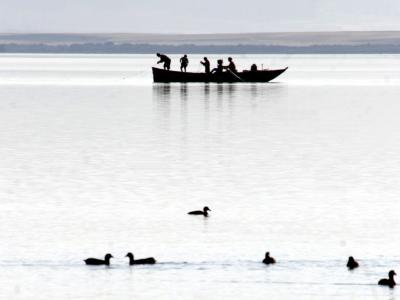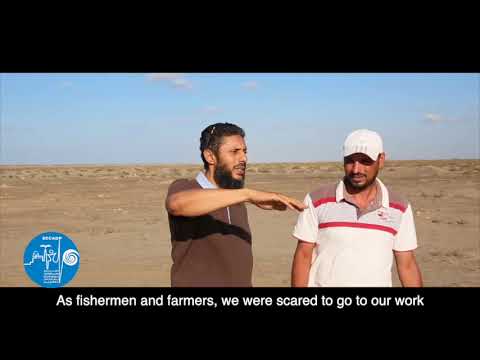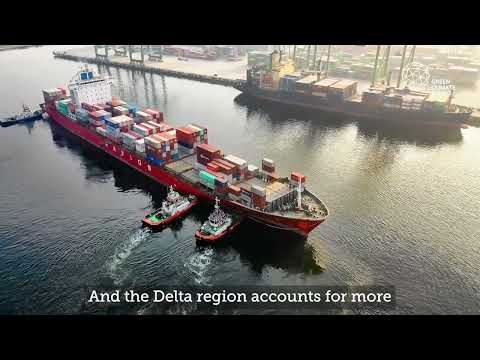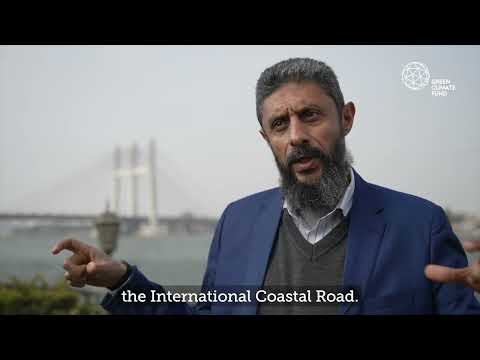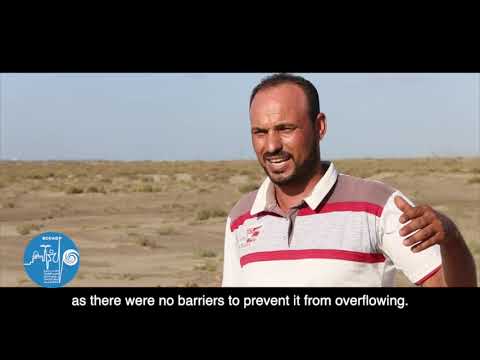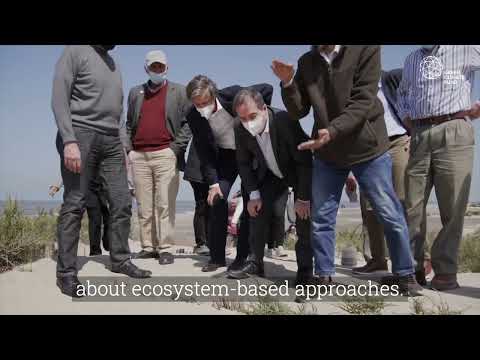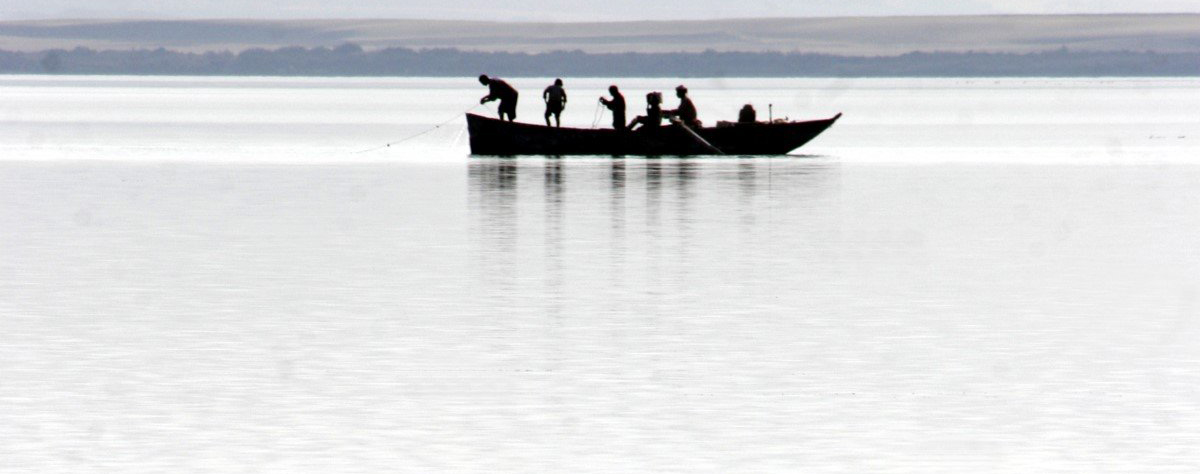
Photo:
The “Enhancing Climate Change Adaptation in the North Coast of Egypt” project aims to protect the densely populated low-lying lands in the Nile Delta, the home of 25 percent of the Egyptian population, which have been identified as highly vulnerable to climate change induced sea-level rise. The project will be implemented by the Ministry of Water Resources and Irrigation with a total budget of US$ 31.4 million over seven years.
Sea-level rise will have a direct and critical impact on Egypt’s infrastructure and development along the low coastal lands. Egypt relies on the Nile delta for prime agricultural land, accordingly coastal inundation or saline intrusion will have a direct and critical impact on Egypt’s entire economy. The number of extreme weather events inducing casualties and economic losses have increased significantly in Egypt over the last ten years. These extreme events have flooded major cities, destroyed infrastructure and disturbed economic activities. In the countryside it has destroyed homes and agricultural lands, and disrupted development initiatives and the Government of Egypt's work to meet sustainable development goals.
With GCF funding, the 7-year project (2018 - 2025) will expand the use of low-cost dikes system to prevent the flooding of the low-lying lands from sea surges during extreme weather events. The dike system was first tested under the pilot level under the GEF Special Climate Change Fund (SCCF) project. The project will also support the development of an Integrated Coastal Zone Management Plan (ICZM) for the North Coast of Egypt that links the plan for shore protection from sea-level rise with the national development plan of the coastal zones. The ICZM plan will be associated with the establishment of a systematic observation system to monitor Oceanographic parameters changes under a changing climate as well as the impact of the different shore protection scenarios on the coastal erosion and shore stability.
- District
- National Governments
The "soft” coastal protection measures will directly benefit approximately 768,164 people and indirectly benefit 16.9 million people in urban and rural communities.
- Egypt Ministry of Water Resources and Irrigation
- Green Climate Fund
- United Nations Development Programme (UNDP)
Expected outcomes
Output 1: Reduced vulnerability of coastal infrastructure and agricultural assets to coastal flooding damage in hotspot locations in Nile Delta
Output 2: Development and implementation of an integrated coastal zone management plan (ICZM) for the entire North Coast of Egypt.
The Enhancing Climate Change Adaptation in the North Coast of Egypt project will reduce coastal flooding risks in Egypt’s North Coast due to the combination of projected sea level rise and more frequent and intense extreme storm events. The first output of the project focuses on the installation of 69 km of sand dune dikes along five vulnerable hotspots within the Nile Delta that were identified during an engineering scoping assessment and technical feasibility study. This will provide a “beneficial reuse” for existing maintenance dredged material from a number of local sources that are operating under existing Government of Egypt approvals. The second project output focuses on the development of an integrated coastal zone management (ICZM) plan for the entire North Coast, to manage long-term climate change risks and provide Egypt with adaptability to impending flood risks. These measures would limit potential displacement of local coastal communities and reduce the number of young people who otherwise would be compelled to search for immigration opportunities.
The barriers that will be addressed by the proposed project include a lack of high quality data to inform planning decisions; absence of a suitable framework for implementing integrated approaches to coastal adaptation; weak institutional coordination to build coastline resilience to sea level rise impacts; the significant reduction of dredge material that would otherwise be disposed into the marine environment; and low institutional capacity to anticipate and manage expected sea level rise impacts. The proposed project will facilitate transformational change in the short-term by reducing coastal flooding threats along vulnerable hotspots in the Delta and in the long-term by integrating additional risks of climate change into coastal management and planning, budgeting and implementation of risk reduction measures.
The “soft” coastal protection measures will directly benefit approximately 768,164 people and indirectly benefit 16.9 million people in urban/rural communities. They have been designed to mirror natural coastal features and/or sand dunes and will transform the areas from high to low risk zones for coastal flooding. They will be stabilized with a combination of rocks and local vegetation species to encourage dune growth by trapping and stabilizing blown sand. Importantly, the coastal protection measures will provide beneficial reuse of existing dredge material that would otherwise be disposed into the marine environment.
The ICZM plan will provide benefits through capacity building to enable high resolution diagnosis of coastal threats, updated regulatory and institutional frameworks to account for sea level rise, and a coastal observation system for ongoing data collection/analysis.
The project is aligned with the Government of Egypt's (GoE) priorities as outlined in its Nationally Determined Contribution to the Paris Agreement and is line with Egypt’s Country Work Programme, as submitted to the Green Climate Fund (GCF). Based on a request made to UNDP by the National Designated Authority (Egyptian Environmental Affairs Agency NDA; Coastal Research Institute (CoRI) and Shore Protection Authority (SPA)), the project is also a part of UNDP’s Work Programme to the GCF and is aligned with Government’s priorities to focus on as per the Country Programme Document, which outlines UNDP’s foci in Egypt.
Climate impacts on Egypt's North Coast
The IPCC has singled out low-lying river deltas to be one of the most vulnerable systems to climate change and sea level rise. Low-lying river deltas are home to millions of people, highly productive agricultural lands, industrial/transport infrastructure and valuable touristic assets. Compounding the vulnerability of these areas is the fact that deltas, areas of land formed from sediment where a river flows into the sea, are sinking due to both natural factors (i.e., compaction of river sediments over time) and anthropogenic factors (construction of dams that restrict the flow of sediment that would otherwise reach the river mouth and build up delta lands, groundwater abstraction). The downward motion heightens vulnerability to coastal flooding, particularly when combined with sea-level rise.
One of the three most vulnerable deltas in the world to climate change is the Nile Delta in Egypt. This region accounts for more than 50% of Egypt’s economic activity through agriculture, industry and fisheries. The Nile Delta contributes about 20% of the Egypt’s GDP and account for the largest source of employment, around 30% of the labor force. As Egypt does not produce enough food to feed its current population, any loss of prime agricultural land due to coastal flooding from sea level rise will have a direct adverse impact on the livelihoods of millions of people and lead to hardship throughout the entire economy.
Coastal areas in the Nile Delta are especially vulnerable to climate variability and changes in sea level. Extreme events that result in increased sea level events, driven by the combination of high tides associated with sea level rise and storm surges, have led to devastating coastal flooding and millions of dollars in damages. The impacts, including the loss of life during coastal floods in Alexandria in 2015, as well as flood waters reaching and threatening to damage the international coastal road located hundreds of meters inland were significant. The rate of sea level rise for the Nile Delta ranges between 3.2 - 6.6mm/year and is due to three major factors; globally rising sea due to thermal ocean expansion; locally sinking land due to compaction of sediments; and loss of annual replenishment of sediments. The IPCC concludes that global mean sea levels have risen between 2.8 and 3.6mm/year from 1993 to 2010. During the same period, local land subsidence has been evident across the entire Delta, with actual rates ranging from about 0.4mm/year in Alexandria to the West to around 3mm/year in Port Said to the East.
Coastal areas in the Nile Delta will be more vulnerable to an increasing frequency and intensity of extreme coastal storms associated with sea level rise. As with many climate change modeling outcome, regional projections at the spatial scale of the Nile Delta suggest that the southern Mediterranean has already seen a measurable increase in the number of natural disasters: from an average of three natural disasters/year in 1980; to an average of>15/year in 2006. An increase in frequency and severity of storm surges is already evident ; and the continuation of rising seas, sinking lands, and more frequent and intense storms is a necessary inference from the review of recent trends and future climate change forecasts.
Economic damages from climate change induced sea-level rise on the North Coast of Egypt has been and will continue to be direct and far-reaching. As of 2017, much of Egypt’s population, industry, agriculture, private sector and tourism infrastructure and development is located along the northern low coastal lands, and the reliance on the Nile Delta for prime agricultural land is critically important to the country’s economy. Studies on the vulnerability of Alexandria, indicated that sea level rise of 0.3m would lead to infrastructure damage worth billions of dollars, displacement of over half a million inhabitants, and a loss of about 70,000 jobs. Moreover, the Nile Delta’s coastal lagoons are among the most productive natural systems in Egypt and they are internationally renowned for their abundant bird life. Approximately 60% of Egypt’s annual fish catch are from three main Delta lagoons, Idku, Burullus and Manzalla, separated from the Mediterranean by 0.5- 3km sand belt and dune system. Coastal flooding and/or permanent inundation of these areas would lead to a decline in water quality in coastal freshwater lagoons and corresponding adverse impacts on fisheries and biodiversity.
Know about coasts subject to harm by climate change in Egypt
Egypt Today
Monday 17th December 2018
Egyptian General Authority for Coast Protection is set to implement several protection projects on the shores of the Mediterranean Sea to protect them from the adverse effects of climate change.
Protection projects should be implemented to some beaches in five different governorates that are believed to be threatened by climate change. The projects aim to enhance the beaches' adaptation to the effects of climate change on the northern coasts and the Nile Delta.
UNDP offers Egypt $31.5 mn for climate change-affected cities
Egypt has received a grant from the Green Climate Fund and the United Nations Development Program (UNDP) worth US$31.5 million, to protect its cities most at risk from climate change, and sea level rises of about 70 km. According to a press statement released by the Ministry of Water Resources and Irrigation, the project will be implemented over seven years, and the agreement will officially signed by the end of this month. The project aims to build a 60-kilometer long wall along the coast of the Nile Delta. Minister of Water Resources and Irrigation Mohamed Abdel Atty said that the ministry will ascribe great importance to the coastal areas of the Central, East and West Delta, which include the governorates of Port Said, Damietta, Dakahlia, Kafr El Sheikh and al-Beheira. These regions are the most vulnerable to the risks of climate change and rising sea levels, while holding a large concentration of people, industry, agriculture, tourism and development projects. In addition to the total submergence of low-lying coastal areas, Abdel Atty noted the risk of severe storms. Such risks prompted the Ministry of Water Resources and Irrigation to establish a long-term plan to protect all coastal areas exposed to erosion, with investments estimated at about LE 3 billion.
Enhancing Climate Change Adaptation in the North Coast of Egypt
The Green Climate Fund (GCF) 18th Board meeting, convened in Cairo, has approved the United Nations Development Program (UNDP) Project entitled “Enhancing Climate Change Adaptation in the North Coast of Egypt” to be implemented by the Ministry of Water Resources and Irrigation. With a total budget of $31.4 million over seven years, the project aims to protect the densely populated low-lying lands in the Nile Delta, the home of 25% of the Egyptian population, which have been identified as highly vulnerable to climate change induced Sea-Level Rise (SLR). The SLR will have a direct and critical impact on Egypt’s infrastructure and development along the low coastal lands.
Green fund approves $31.4 mln UNDP project to protect Egypt's Delta from climate change
The Green Climate Fund (GCF) approved on Sunday a $31.4 million United Nations Development Programme (UNDP) project to protect Egypt's Nile Delta from rising sea levels due to climate change, the UNDP said in a press statement. The project titled “Enhancing Climate Change Adaptation in the North Coast of Egypt” will be implemented by the Egyptian Ministry of Water Resources and Irrigation over seven years. The GCF is a global fund that offers support to developing countries to deal with the challenge of climate change. The approval for the project came during the GCF's 18th board meeting in Cairo from Saturday to Monday.
Output 1: Reduced vulnerability of coastal infrastructure and agricultural assets to coastal flooding damage in hotspot locations in Nile Delta
The project will enable reducing vulnerabilities of assets and populations through promoting and scaling up a set of “soft engineering solutions” and ecosystem-based coastal protection measures that can sustain proper ecosystem functioning and productivity in each of the coastal lagoons such as the conservation of existing wetlands and enhancement of their functionality. A UNDP-GEF-SCCF Climate Change Adaptation in the Nile Delta Project has tested the design and feasibility of several soft engineering solutions for coastal protection (namely beach nourishment and using of geotubes and low cost soft dikes to alleviate impacts of extreme weather events on infrastructure and human settlements) per the geomorphologic, climatic, and development characteristics of the Nile Delta area. The initial results confirm the effectiveness of these designs and have been accepted by the Egyptian coastal engineering community.
The project will scale up the use of soft engineering solutions and ecosystem-based approaches to coastal protection. The proposed interventions are no-regret interventions that need to be done no matter what priorities emerge from the ICZM plan given the incidence of coastal flooding that is currently occurring. It will support the implementation of specific measures include developing a ‘vegetative buffer’ structure for coastal protection, re-nourishing beaches, reinforcing sand dune systems as a defense mechanism, re-vegetation to stabilize seabed sediment, wetland restoration and the establishment of conservation zones to preserve essential coastal habitats.
Activity 1.1 focuses on the development of soft coastal protection (pre-construction) detailed designs, and site-specific assessments undertaken for protecting 69 km of the Nile Delta in 5 vulnerable hotspot locations.
Sub-Activity 1.1.1: Generation of local data needed to characterize the vulnerable hotspot locations including, but not limited to, digital elevation maps, geomorphology, wave characteristics, storm events, erosion/accretion trends, and other data needed to assess the suitability of soft coastal protection measures subject to the combined impact of sea level rise and extreme storm events.
Sub-Activity 1.1.2: Use of the local data generated to undertake flood modeling with and without soft coastal protection in order to establish detailed design characteristics for each of the hotspot locations
Sub-Activity 1.1.3: Finalization of all in-depth design documents, specifications, and engineering drawings necessary for the development of a comprehensive bill of quantities for the soft protection measures.
Activity 2.1 focuses on constructing location-specific coastal soft protection structures at the 5 vulnerable hotspot locations. It will involve the following major sub activities:
Sub-Activity 1.2.1: Initiate a tendering process to select local contractor(s) to construct the coastal protection measures, including quality control requirements, based on the finalized design documents and bill of quantities.
Sub-Activity 1.2.2: Carry out all site preparation activities associated with clearing, grubbing, stripping, dewatering and any other activities associated with site preparation at the five locations.
Sub-Activity 1.2.3: Construct the 5 coastal protection measures, including all excavation, fill placement/compaction, rip-rap placement, geotextile placement, and final grading.
Sub-Activity 1.2.4: Conduct and maintain records for site inspection during the construction period, including environmental safeguard monitoring during the lifetime of the coastal protection works
Activity 3.1 focuses developing and implementing an operations & maintenance programme for the installed soft protection structures. It will involve the following major sub activities:
Sub-Activity 1.3.1: Develop a soft coastal protection maintenance manual to govern future maintenance and rehabilitation activities, tailored to Nile Delta conditions.
Sub-Activity 1.3.2: Codify the procedures in the manual within the governing regulations of the SPA.
Sub-Activity 1.3.3: Conduct operations and maintenance activities over the lifetime of the project consistent with the coastal protection maintenance manual.
Output 2: Development and implementation of an integrated coastal zone management plan (ICZM) for the entire North Coast of Egypt.
The impacts of climate change on the north coast, especially regarding sea level rise, will further place the Nile Delta and the entire North Coast at risk. On the one hand, impacts such erosion and flooding will increase under different climate change scenarios with sea level rise, causing damages and losses in the coastal system (infrastructures, housing, livelihoods, coastal resources, etc.) leading to human migration outside and inside the country. On the other hand, key stakeholders will need stronger mechanisms to collaborate and join forces to face climate change challenges. A shift away from business-as-usual practices in coastal management is needed urgently to cope with sea level rise which is already occurring. The goal of long-term resilience building and risk reduction under climate change threats in the north coast requires a new planning paradigm, one offered by the implementation of the ICZM plan.
Activity 2.1 focuses on the development of national capability to conduct long-term climate change risk-induced hazard, vulnerability and risk high resolution assessments of erosion and flooding under climate change scenarios on an ongoing and iterative basis. This activity will include training in methods for the characterization of marine dynamics, establishment of databases and tools to model shoreline dynamics, high-resolution (HR) hazard assessment, and HR exposure, vulnerability and risk assessment. The assessments will be performed for different scenarios: current situation and long term scenarios (considering climate change and future coastal developments). The risk assessment will be performed at two different geographical scopes and scales: national for the whole north coast (based on the hazard assessment performed under the ICZM Scoping Study) and local at selected priority areas. The results of the process will lead to the selection of the next set of priority areas. It will involve the following major sub-activities:
Sub-Activity 2.1.1: Characterization of marine dynamics based on the numerical modelling of wind, waves, currents and sea level change in the future.
Sub-Activity 2.1.2: Establishment of coastal modeling systems consisting of databases, methods and tools suitable for modeling shoreline dynamics in the North Coast context.
Sub-Activity 2.1.3: Conducting high-resolution hazard assessment under a set of climate change scenarios to develop flooding maps that account for storm surge inundation levels that factor in projected sea level rise.
Sub-Activity 2.1.4: Conducting of vulnerability and risk high resolution assessment under climate change scenarios to integrate the exposure of coastal areas and their sensitivity to flooding and erosion impacts.
Activity 2.2 focuses on the development of a climate change risk-informed ICZM plan to include a shoreline management plan and a regulatory/legislative/institutional framework. This is the core activity of the ICZM policy cycle where the ICZM plan for the North Coast of Egypt is developed. It is estimated that the complete process for the development of the ICZM plan including the supporting frameworks will need five years. However, it is expected that there will be outputs from the ICZM plan starting from the third year of the project. Accordingly implementation of the urgent coastal protection measures will overlap with the development of ICZM plan. The ICZM Plan is essentially a planning tool that defines the objectives and measures necessary to achieve a climate-resilient development of the North Coast. It will consist of a Shoreline Management Plan (SMP) and a Coastal Management Plan (CMP), as mentioned earlier. It will involve the following major sub-activities:
Sub-Activity 2.2.1: Development of a Shoreline Management Plan for climate change adaptation to define the most promising shoreline management measures for climate change adaptation, and their implementation strategy.
Sub-Activity 2.2.2: Development of a regulatory and legislative framework to ensure the effective implementation of climate change adaptation activities under ICZM principles.
Sub-Activity 2.2.3: Development of an institutional governance mechanism at the national and governorate levels to ensure a shared ownership of the ICZM Plan with concerned authorities and civil society groups in the planning process.
Sub-Activity 2.2.4: Establishment of the monitoring and evaluation system to enable managers to take appropriate corrective actions to achieve the expected results of the plan by evaluating the progress of the plan implementation.
Sub-Activity 2.2.5: Initiate implementation of the coastal protection measures generated from the ICZM plan
Activity 2.3 focuses on the development of a capacity building program on climate change risk management for institutions involved in the long-term management of the north coast. The program will create the basis for a thorough understanding of various aspects of coastal management, including climate change adaptation and ICZM, as well as promoting collaborative networks equipped with the necessary skills, knowledge and attitudes to undertake different tasks involved in the climate change adaptation and planning of the coastal areas of Egypt. The framework for the program will aim to identify gaps and corresponding capacity needs relative to key ICZM implementation issues, and to build capacity of individuals and institutions to implement the ICZM Plan. It will involve the following major sub-activities:
Sub-Activity 2.3.1: Assessment of capacity needs for ICZM planning to catalog on-going coastal management capacity building activities, and to identify gaps in skills, knowledge and attitudes for the practice of ICZM and climate change adaptation.
Sub-Activity 2.3.2: Transfer of coastal observation and modelling systems to coastal management to ensure that staff from selected institutions have the necessary scientific knowledge to assimilate and integrate both the coastal observation and modelling systems.
Sub-Activity 2.3.3: Design and implementation of modular training program for MWRI/SPA and EEAA to build skills for professional development of coastal management practitioners, in a diversity of capacities (e.g. policy positions or day-to-day management).
Sub-Activity 2.3.4: Design and implementation of the modular training program for other stakeholders to be able to collaborate and actively participate in the implementation of the ICZM Plan.
Sub-Activity 2.3.5: Monitoring and evaluation of the capacity building program's results.
Sub-Activity 2.3.6: Design and implementation of a programme to promote sustainable livelihoods of poor women in hotspot areas for household income diversification and other community development activities
Activity 2.4 focuses on the implementation of specific components of a national observation system. The National Observation System has already been designed (see Annex IIa). It will involve the following major sub-activities:
Sub-Activity 2.4.1: Procurement and installation of an observation/monitoring equipment relative to meteorological, oceanographic, networking, and other operational objectives for coastal zone management of climate change induced risks on coastal areas.
Sub-Activity 2.4.2: Development and implementation of a capacity building programme for MWRI/SPA and EEAA that focuses on training in the operation of all elements of the national observation system, including systems for coordination with coastal zone analysts/modelers who will use the data generated.
Sub-Activity 2.4.3: Design and implementation of a quality control/assurance programme amongst the participating institutions and agencies for the collection, evaluation, and distribution of data generated from the various components of the national observation system.
- UNDPRandall PurcellRegional Technical Advisor, Climate Change Adaptation


